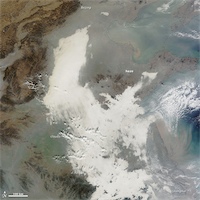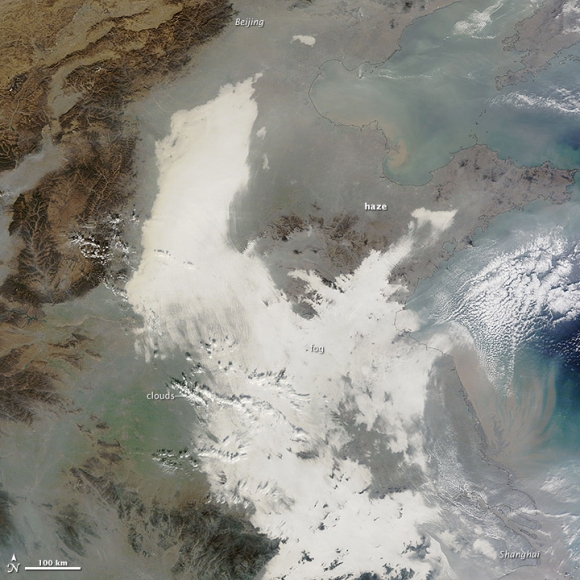China’s current air pollution is so bad, it’s visible from space!
posted Friday, December 13, 2013 at 2:11 PM EDT

China is currently in the midst of battling a rather astonishing bout of air pollution, most notably in Shanghai and Beijing. Not only is this level of pollution extremely dangerous but it's so thick and blanketing that a new image from NASA shows the smog cloud from space.
The image below shows a combination of both fog (white) and smog (grey). On the NASA Earth Observatory blog, they explain:
China suffered another severe bout of air pollution in December 2013. When the Moderate Resolution Imaging Spectroradiometer (MODIS) on NASA’s Terra satellite acquired this image on December 7, 2013, thick haze stretched from Beijing to Shanghai, a distance of about 1,200 kilometers (750 miles). For comparison, that is about the distance between Boston, Massachusetts, and Raleigh, North Carolina. The brightest areas are clouds or fog. Polluted air appears gray. While northeastern China often faces outbreaks of extreme smog, it is less common for pollution to spread so far south.
At the time of this image, the Air Quality Index for Beijing hit 487 — anything above 300 is considered dangerous to human health. The US embassies in Beijing and Shanghai are reporting fine particulate matter up to 480 and 355 micrograms per cubic meter of air, where being above 25 is unsafe according to the World Health Organization.
The smog is so bad, it's been dubbed extremely hazardous, been cause for school cancelations and flight delays.
This problem isn't unique to China. For decades, London had notoriously bad smog, which at one point killed 4,000 people over the course of just a few days. But what's new is that now we have a much better grasp of the damages this level of pollution can cause, and the technology to see its full extent. Images like this one from NASA provide us with the context of this pollution — and shows just how incredibly large the problem really is.
(via io9)
